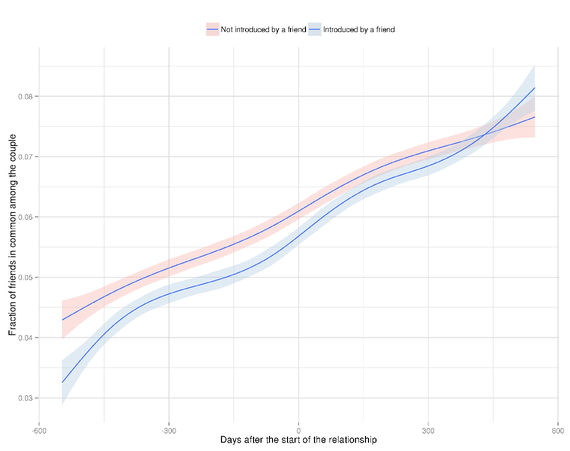Last year, Facebook’s data team examined how interactions between friends change as they inch toward dating. “During the 100 days before the relationship starts, we observe a slow but steady increase in the number of timeline posts shared between the future couple,” data scientist Carlos Diuk wrote. He added that, after a relationship began, the number of timeline posts dropped off.
This year, Facebook has done a slight variation on the experiment. We know what it looks like on Facebook when two people fall in love—so what does it look like before two lovers meet?
To find out, Facebook found couples who had started a relationship more than one year ago but less than two years ago. (In other words, couples who started dating after February 2013 but before February 2014.) The data science team then surveyed 1,500 of them, asking if a mutual friend had introduced them or if they had met through other means. Finally, they analyzed the friend networks of the happy couples and the successful matchmakers.
They unveil their findings in a new blog post. As the team notes, typical matchmakers don’t look like the maternal Yente of Fiddler on the Roof fame. Instead, they look like the millennials they were mostly introducing:
They were young (most often in their 20s, as were most of the survey respondents), half of them were men, and roughly half of them were single (much like most of the future couple's other friends).
Intriguingly, they found that matchmaker networks differed from the couples they analyzed: On average, matchmakers had more friends than their matchmakees, and, indeed, more friends than the average friend of a matchmakee. The friendship paradox—the idea that your friends have more friends than you do—is a popular one in network science, but the study’s matchmakers usually have more friends than your friends do.
Those friend groups, though, are also more disparate: Matchmakers are social butterflies.
Most interesting to me, however, was that people who met “by themselves” tended to have more mutual friends than those introduced by mutual friends. That makes a certain amount of sense, probably: People tend to meet each other in more dense social networks. But it does play with the idea of the matchmaker—they become more of a connector between two different networks than someone strengthening bonds inside it.

As always, with these studies, it’s worth considering what these results tell us about what Facebook can see into our social lives. One thing I appreciate here, though, is that they surveyed the couples they wrote about: Couples, in other words, had a sense they were being examined.
This article was originally published at http://www.theatlantic.com/technology/archive/2015/02/facebook-and-the-art-of-matchmaking/385519/
